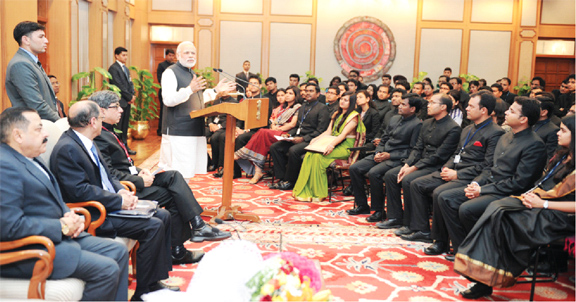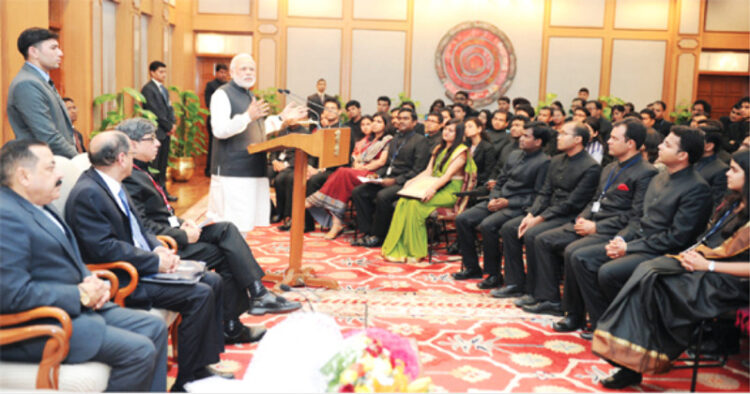 Bureaucracy in Bharat carries a heavy baggage of colonial times,which it needs to replace with “seva bhaav” for the poor and the downtrodden
Bureaucracy in Bharat carries a heavy baggage of colonial times,which it needs to replace with “seva bhaav” for the poor and the downtrodden
Uday Sahay
A chilling remark made by a political observer, soon after the Independence, on the personnel, rules, and values
components of the Indian bureaucracy summed up the situation then. It said, “Indian Civil Service is neither Indian, nor civil, nor a service”.
The interesting part is that it holds the scenario no less true even today. It is the right time, therefore, to
dissect the observation in the light of the current situation.
The first Prime Minister was a liberal romantic, who wanted traditional Indian Postman (on the model of Ireland) kind of public servants with acute service-orientedness to become civil servants.
On the other hand, the first Home Minister was a realist. He wanted it to get services Indianised in character, but not during the strife situation that emerged soon after the Independence. He wanted civil service to retain steel frame character. He had a task of ensuring Unity and Integrity of India by bringing 562 Princely States under India’s fold. Junagarh, Hyderabad, and J& K were trouble spots. Communal strife in eastern and western Border States was source of anxiety. Tackling these issues deftly earned Patel the title of Sardar and Bismarck of India. But he could not take the services to the next level.
Mrs Indira Gandhi attempted Committed Bureaucracy concept, but that did not sustain because of the personal loyalty demands. “Changes were cosmetic and
incremental at best, not structural”.
First major attempt to change the TANTRA (Bureaucracy) was after the Janata Party came to power in 1977. The Kothari Commission was set up. Its recommendation led to the introduction of vernacular languages in the civil services examination—a major reform in the democratisation of recruitment base of civil servants. But its other
recommendations were shelved. Taking cues from it, one of the Commissions set up later
recommended ‘introducing another set of exams for all the service members for filling up the top management positions in the government’.
It was heavily resisted by the IAS lobby which didn’t want to give up its highest caste-like status in the government. Whatever reasons they would have cited, but they were an interested party and they feared competition from non-IAS service members, many of whom may elbow them out if such an examination was to be held again mid-service. This is so because in terms of exposure an IAS officer definitely has an edge over other services, but the fact remains that every service throws up few extraordinary talents who can compete or even beat the best in IAS. N Shreedaran of Metro fame is an apt example.
Some Experiments
As a compromise, theoretically a central staffing scheme was introduced for filling up the top positions in the government where all civil servants or even outside experts were eligible, but in practice, it faces resistance every day. As a result, not even 5 percent of the topmost positions in the Central or state positions were occupied by non-IAS officers earlier.
The Modi government has experimented this by broad-basing central staffing positions by opening it more and more to other services at the level of Joint Secretary at the Centre. As a result, it is believed that nearly 65 percent of the Joint Secretary level posts at the central level today are held by non-IAS officers. These need to be rationalised and institutionalised. It is reiterated that after 16 years of service, another set of examination, open to all in-service civil services officers, be conducted to screen officers from a combined superior service to hold all posts of Joint Secretaries and above.
All Commissions on Administrative Reforms set up so far, therefore, have turned out to be an exercise in self-perpetuation. These Commissions have been headed by retired IAS officers only, who end up saying the ‘the
workload has increased without commensurate manpower and hence convert the department into a ministry and create more posts of Secretaries’ Structural change is never attempted in the process.
“We need to depend on wisdom and deeper character required of an ideal civil servant, more than intelligence?” When the Modi government came with a huge mandate, a new hope was in the air that he may attempt a structural change in the bureaucracy. His tough posturing and initial straight talk did create a fear in the minds of slothful and corrupt bureaucrats but it ended up finally in merely securing timely attendance in the Government of India offices, thanks to bio-metric attendance equipment. The 360 degree evaluation of civil servants is yet another major successful change introduced to transform the personnel management policy.
Corruption on the top has been controlled too and evaluation of the performance of officers has indeed undergone change, but the structural reform is still not given any attention.
What Next?
We must set right and balance our priority by giving equal weight to change both, personnel structure and rules structure.
We need to set up a Commission on Administrative Reforms
comprising a mix of retired civil servants of major services and international domain experts with a stiff one-year time-frame.
The Commission should quickly study the best practices of
governance across the globe, and pick up those suitable to meet the needs of the hour of India.
Rules concerning Recruitments, Placements, Services, Conduct, Discipline, Appraisal, Allocation of Business Rules, Financial Rules, Communication, and Vigilance need to be drafted afresh—since they are the foundational structures of governance. Further, from a system based on Files pushing, the time has come to graduate to paperless online or digital route to decision making in governance.
Personality traits suited for particular public service need to be drawn up and premium should be given to traits such as Integrity, Comprehension, Correlating, Wisdom or balance, Speed, Penchant for meeting timeline etc.
The focus needs to change from intelligence to deeper character and wisdom of balance. The value- foundation needs to be “seva” (service). The power orientation ought to be based on “seva bhaav”, not on self-aggrandisement. Their outlook should carry compassion for poor and the marginalised, not greed to serve the rich and the powerful. Gandhi’s Talisman of the last man’s interest needs to be hammered during training. A bureaucrat needs to be made to understand that their privileges are paid through public money.
Change the UPSC exam pattern accordingly and recommend similar change for states. Focus on Emotional Quotient and Spiritual Quotient than merely on Intelligence Quotient.
There have been several imaginative initiatives and there are several outstanding officers, effective and honest. But the pace, scale and scope of change hitherto have been limited or only incremental in nature.
(The writer is a former IPS and Director, SAUV Communications Private Limited)














Comments